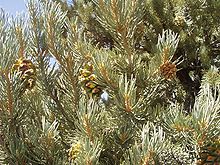Piñon pine
| Pinyon pines | |
|---|---|
 |
|
| Single-leaf pinyon (Pinus monophylla subsp. monophylla) | |
| Scientific classification | |
| Kingdom: | Plantae |
| Division: | Pinophyta |
| Class: | Pinopsida |
| Order: | Pinales |
| Family: | Pinaceae |
| Genus: | Pinus |
| Subgenus: | Strobus |
| Section: | Parrya |
| Subsection: | Cembroides |
| Species | |
|
See text. |
|
See text.
The pinyon or piñon pine group grows in the southwestern United States and in Mexico. The trees yield edible pinyon nuts, which were a staple of the Native Americans, and are still widely eaten as a snack in New Mexican cuisine. The name comes from the Spanish Pino piñonero, a name used for both the American varieties and the Stone Pine common in Spain, which also produces edible piñon nuts typical of Mediterranean cuisine. Harvesting techniques of the prehistoric Indians are still being used to today to collect the pinyon seeds for personal use or for commercialization. The pinyon nut or seed is high in fats and calories.
Pinyon wood, especially when burned, has a distinctive fragrance, making it a common wood to burn in chimineas. The pinyon pine trees are also known to influence the soil in which they grow by increasing concentrations of both macronutrients and micronutrients.
Some of the species are known to hybridize, the most notable ones being P. quadrifolia with P. monophylla, and P. edulis with P. monophylla.
The two-needle piñon (Pinus edulis) is the official state tree of New Mexico.
Genetic differentiation in the pinyon pine has been observed associated to insect herbivory and environmental stress.
There are eight species of true pinyon (Pinus subsection Cembroides):
These additional Mexican species are also related and mostly called pinyons:
The three bristlecone pine species of the high mountains of the southwestern United States, and the lacebark pines of Asia are closely related to the pinyon pines.
The seeds of the pinyon pine, usually called "pine nuts," or simply "piñons" by the Navajo, were an important food for pre-historic Indians living in the mountains of southwestern United States and northern Mexico. The nuts continue to be gathered, eaten, and marketed. All species of pine produce edible seeds, but in North America only pinyon produces seeds large enough to be a major source of food.
...
Wikipedia
